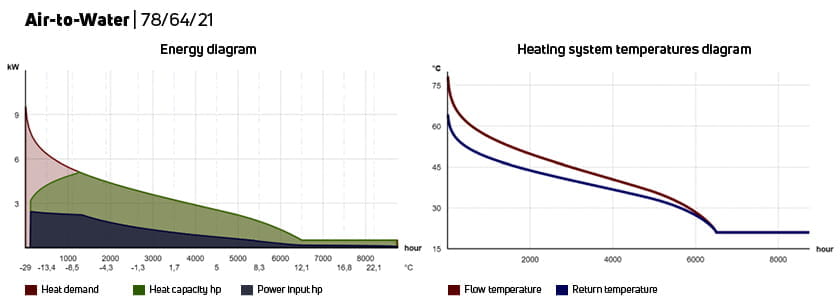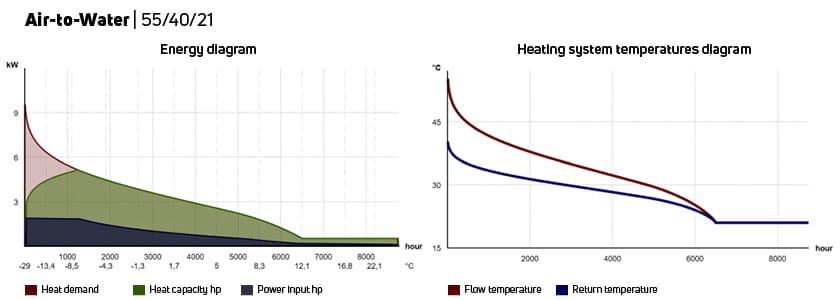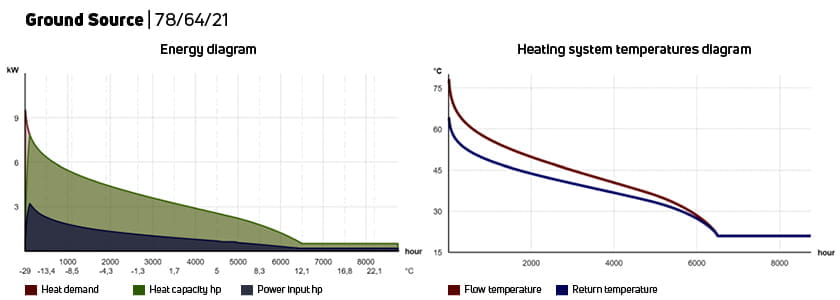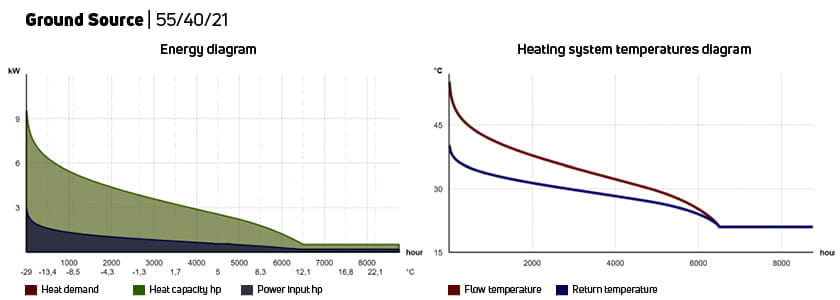- Better integration
- Energy saving
- Hydronic heating
- Radiators
2 heat pump systems compared: evaluating costs and efficiency when switching to low-temperature radiators
Heat pump systems in a retrofit project
For the purpose of our simulation we compare the two heat pump systems in a 1970s detached house located in Central Finland. The house is 150 m², and its heating demand, including space heating and hot water, is 9.5 kW. The climatic conditions are quite demanding with a design outdoor temperature of -29 °C.
The first system consists of an air-to-water heat pump initially combined with an old radiator system with design temperatures of 78/64/21 °C, and then with modern panel radiators resized for low temperature heating at 55/40/21 °C. The second case is a ground source heat pump, also first combined with an old radiator system with design temperatures of 78/64/21 °C and then a new low-temperature radiator system with 55/40/21 °C.
The calculations for these systems have been made using the NIBE DIM heat pump sizing software. The selected heat pump models are air-to-water heat pump Nibe S2125-8 and ground source heat pump Nibe F1155-12.
Heat pump performance results
The reason we don’t just compare the two heat pumps but also their efficiency when combined with different radiators is to demonstrate once again the importance of considering the heating system as a whole. Mikko Iivonen, Retired R&D Adviser at Purmo Group says: “When replacing the heat source of a heating system, such as a gas or oil boiler, with a heat pump, it’s not always understood how important it is to also replace the heat emitters to match a low-temperature system. This will allow for the system temperatures to be lowered, which in turn ensures the energy efficiency and economy of a heating system based on a heat pump.”
“Moreover, it’s often understood that only underfloor heating is suitable for heat pumps. However, this is a mistake. Low-temperature radiators are an excellent solution, especially in renovations. Radiators are very energy-efficient. They react quickly to changes in room temperature under thermostat control, and the heat losses are lower than competing systems.”
Read more about low-temperature radiators for heat pumps
In our simulation we clearly see that when the heating system's design temperature is changed from 78/64/21 °C to 55/40/21 °C and the old radiators are replaced by new ones, the system’s performance significantly improves and electricity consumption drops proportionally as a result.
Air-to-water heat pump: Ground source heat pump:
- Heat pump SPF: +19,7% - Heat pump SPF: +26,4%
- System SPF: +17,2% - System SPF: +29,6%
- Electricity savings: 17,2% - Electricity savings: 29,6%
SPF = Seasonal performance factor
| Air-to-water | Ground source | |||
| 78/64/21 °C | 55/40/21 °C | 78/64/21 °C | 55/40/21 °C | |
| Total heating energy | 2,4631 kWh (of which 4,500 kWh for domestic hot water) | |||
| Heat pump heat output | 21,661 | 22,096 | 24,244 | 24,631 |
| Additional heat demand | 2,969 | 2,533 | 387 | 0 |
| Electricity usage heat pump | 8,163 | 6,954 | 7,896 | 6,319 |
| Purchased electricity | 11,246 | 9,596 | 8,451 | 6,519 |
| Heat pump SPF | 2,654 | 3,178 | 3,070 | 3,879 |
| Heating system SPF | 2,190 | 2,567 | 2,915 | 3,778 |
Table: performance results of the heat pump calculations in simplified form. Energy unit = kWh/a
Charts
System 1: air-to-water heat pump
Design temperatures: 78/64/21 °C

Design temperatures: 55/40/21 °C

System 2: ground source heat pump
Design temperatures 78/64/21 °C

Design temperatures: 55/40/21 °C

Analysis of the calculation results
The annual heat coefficient of the entire heating system (SPF system) provides a better picture of energy efficiency and electricity usage compared to the annual heat coefficient of the heat pump (SPF). In the given examples, when all electrical functions, including additional heating, are powered by purchased electricity, changes in SPF system reflect in electricity usage accordingly.
Transitioning to a low-temperature system (55/40/21°C) improves the annual heat coefficient of the ground source heat pump system by about 30%. This has a significant impact on annual electricity consumption, reducing it by approximately 30%. At an electricity tariff of € 0.17/kWh, the average price of electricity without taxes in Finland in June 2024, this translates to about € 430 in annual savings.
The electricity consumption of an air-to-water heat pump system decreases by about 17% when switching to a low-temperature system, which, at a tariff of € 0.17/kWh, equates to around € 280 in annual savings.
Conclusion
Our simulation confirms that when transitioning from a traditional heating system fuelled by oil, gas, or electricity to heat pump heating, it is crucial to resize radiators for a low-temperature system where water temperatures are 55°C or lower. This offers significant energy savings and allows for the radiators to be tailored to the room’s current heat demand, which may have decreased following energy interventions such as new windows or extra insulation, as well as to the room layout or interior design. Moreover, it has been observed that the lifespan of a heat pump is extended when transitioning to a low-temperature system. Lower compressor pressures result in less wear on the heat pump. It should be noted, however, that resizing radiators is the work of a qualified HVAC professional who considers both energy and aesthetic requirements.
According to the examples, in a medium-sized 1970s detached house, choosing an air-to-water heat pump results in about 17% annual electricity savings from radiator replacement, corresponding to approximately € 250-300 in annual savings at current electricity prices. Conversely, with a ground source heat pump, annual electricity savings are about 30%, or € 400-450.
Mikko observes: “In Finland, the investment costs of heat pumps installed in a detached house like our example are typically € 12,000 to 16,000 for an air-to-water heat pump system and € 25,000 to 32,000 for a ground source heat pump system. The profitability and payback time of the investment can be calculated when knowing the annual operating costs of the old system, the investment cost of the new system and the annual operating costs are approximated. Several European countries have national subsidies for switching from fossil heat sources to heat pump systems.”
The price of electricity in Finland is likely to rise, as it is currently among the lowest in Europe. Future higher electricity prices will also favour more energy-efficient solutions, such as transitioning to a low-temperature system. Mikko adds: “The calculation above is based on the climatic conditions of Central Finland. Yet, we need to keep in mind that the choice of heat pump, type and model, is influenced by several factors, such as the characteristics of the building, climatic conditions, green values, the price of energy and its development prospects, and the key factor is investment costs. It can be stated that the air-water heat pump is generally a more profitable choice in warmer climates so if we would perform a similar calculation for that type of climate, we expect the air-to-water heat pump to produce better results.”
Read more about saving energy with the heating system
If you have any questions about combining a heat pump with radiators, we recommend you read our dedicated article. If you would like advice on how best to combine a heat pump with other components in the heating system, don’t hesitate to get in touch with our experts. We are happy to offer tailored advice.

